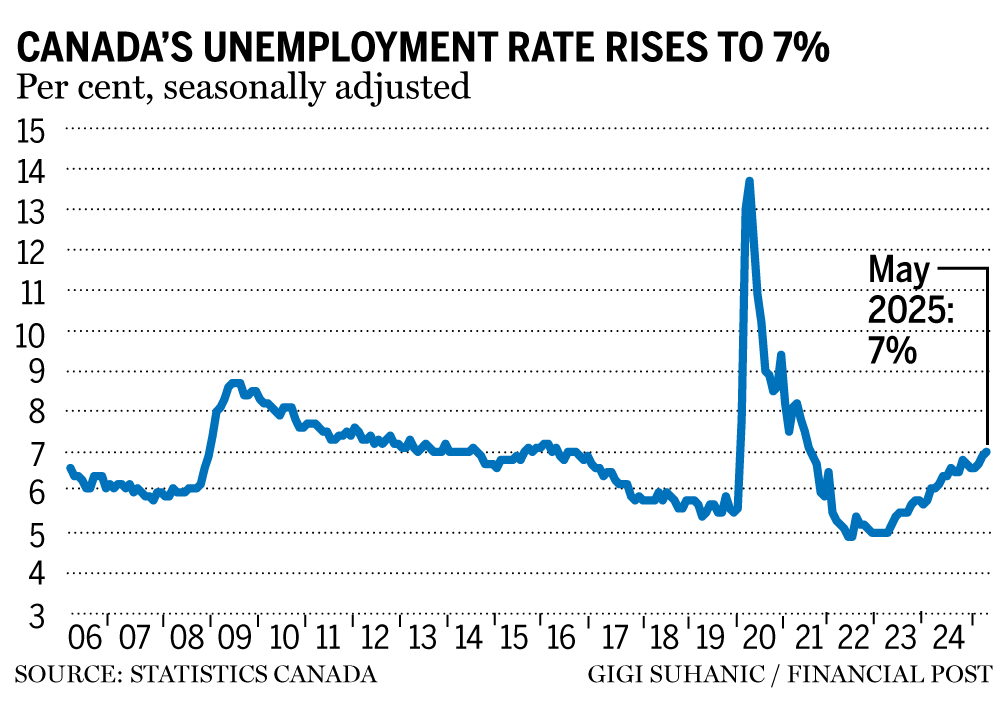Canada’s
climbed to seven per cent in May, its highest level in over eight years excluding the pandemic, with the economy
.
The unemployment rate has risen by 0.4 percentage points since February, as uncertainty brought on by U.S. tariffs has dampened hiring.
Despite the jobless rate climbing, Canada’s job market showed resilience in May, with full-time employment increasing by 58,000, offset by a decline in part-time work,
Statistics Canada said on Friday.
In May, employment in the private sector increased by 61,000, while public sector employment fell by 21,000, after a jump in April that was attributed to hiring temporary workers for the federal election.
Employment rose in wholesale and retail trade, utilities, information, culture and recreation and finance, real estate, insurance, rental and leasing. Employment declined in manufacturing, public administration, transportation and warehousing, accommodation and food services and business, building and other support services.

“The
shows up in the industry pattern and regional unemployment pattern,” said Leslie Preston, senior economist at Toronto-Dominion Bank, in a note to clients. “The manufacturing sector was down 12,200, as was transportation and warehousing (-15,000).”
Preston said manufacturing has lost a total of 55,000 jobs over the past four months.
Overall job postings have been holding steady since February, but are down more sharply in trade sensitive regions like Saint John, Sault Ste. Marie, Ont., and Windsor, Ont., said Indeed Canada senior economist Brandon Bernard in a note.
Windsor’s unemployment rate hit 10.8 per cent as the city grapples with the economic uncertainty brought on by tariffs on motor vehicles and parts while Oshawa’s rate rose to 9.1 per cent.
May also marks the beginning of the student summer job market, with the unemployment rate among returning students aged 15 to 24 reaching 20.1 per cent, which is comparable to the high rates seen in May 2009 and May 1999, excluding the pandemic.
This deterioration in the labour market will be top of mind for the
in the next few months, as it monitors how U.S. trade uncertainty is impacting the Canadian economy. The central bank decided to hold its policy rate at 2.75 per cent on Wednesday, after core inflation came in hotter than expected in April.
In a speech on Thursday, Bank of Canada
deputy governor Sharon Kozicki said
policymakers also relied on real-time survey data from trade-impacted businesses for its latest decision, where they were hearing less talk of “catastrophic outcomes” from business leaders.
Still, economists said the larger trend of the rising unemployment rate, could mean further rate cuts by the Bank of Canada during the second half of this year. While estimates vary, economists expect the jobless rate to peak above seven per cent this year.
“We expect that the gradual rise in joblessness will continue into the second half of the year, with positive developments regarding U.S. tariffs and some further interest rate cuts from the Bank of Canada required to help stabilize conditions before year-end and bring a reduction in the unemployment rate again in 2026,” said Andrew Grantham, senior economist with the Canadian Imperial Bank of Commerce, in a note.
The employment rate remained unchanged at 60.8 per cent, matching the low observed in October 2024. The layoff rate, which represents the proportion of people who were employed in April but had become unemployed due to a layoff in May, was unchanged compared to the year before.
Total hours worked were unchanged in May, but were up 0.9 per cent compared to the year before. Average hourly wages increased 3.4 per cent year-over-year, the same growth observed in April.
• Email: jgowling@postmedia.com
Bookmark our website and support our journalism: Don’t miss the business news you need to know — add financialpost.com to your bookmarks and sign up for our newsletters here.